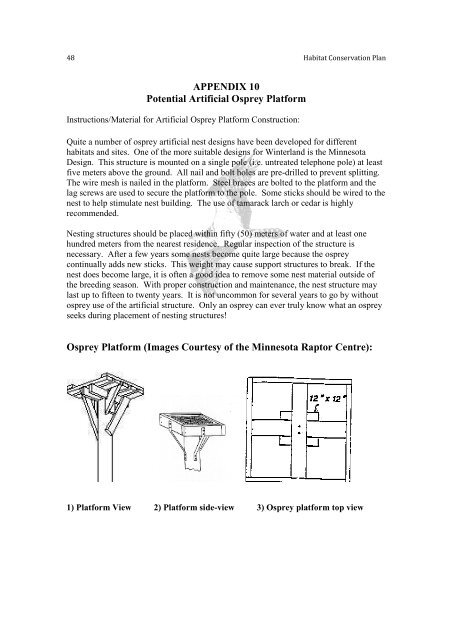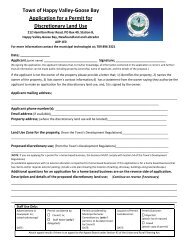Habitat Conservation Plan Habitat Conservation Plan for the Town ...
Habitat Conservation Plan Habitat Conservation Plan for the Town ...
Habitat Conservation Plan Habitat Conservation Plan for the Town ...
- No tags were found...
Create successful ePaper yourself
Turn your PDF publications into a flip-book with our unique Google optimized e-Paper software.
48 <strong>Habitat</strong> <strong>Conservation</strong> <strong>Plan</strong>APPENDIX 10Potential Artificial Osprey Plat<strong>for</strong>mInstructions/Material <strong>for</strong> Artificial Osprey Plat<strong>for</strong>m Construction:Quite a number of osprey artificial nest designs have been developed <strong>for</strong> differenthabitats and sites. One of <strong>the</strong> more suitable designs <strong>for</strong> Winterland is <strong>the</strong> MinnesotaDesign. This structure is mounted on a single pole (i.e. untreated telephone pole) at leastfive meters above <strong>the</strong> ground. All nail and bolt holes are pre-drilled to prevent splitting.The wire mesh is nailed in <strong>the</strong> plat<strong>for</strong>m. Steel braces are bolted to <strong>the</strong> plat<strong>for</strong>m and <strong>the</strong>lag screws are used to secure <strong>the</strong> plat<strong>for</strong>m to <strong>the</strong> pole. Some sticks should be wired to <strong>the</strong>nest to help stimulate nest building. The use of tamarack larch or cedar is highlyrecommended.Nesting structures should be placed within fifty (50) meters of water and at least onehundred meters from <strong>the</strong> nearest residence. Regular inspection of <strong>the</strong> structure isnecessary. After a few years some nests become quite large because <strong>the</strong> ospreycontinually adds new sticks. This weight may cause support structures to break. If <strong>the</strong>nest does become large, it is often a good idea to remove some nest material outside of<strong>the</strong> breeding season. With proper construction and maintenance, <strong>the</strong> nest structure maylast up to fifteen to twenty years. It is not uncommon <strong>for</strong> several years to go by withoutosprey use of <strong>the</strong> artificial structure. Only an osprey can ever truly know what an ospreyseeks during placement of nesting structures!Osprey Plat<strong>for</strong>m (Images Courtesy of <strong>the</strong> Minnesota Raptor Centre):1) Plat<strong>for</strong>m View 2) Plat<strong>for</strong>m side-view 3) Osprey plat<strong>for</strong>m top view






